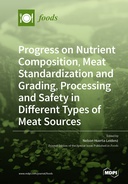Explore

Progress on Nutrient Composition, Meat Standardization and Grading, Processing and Safety in Different Types of Meat Sources
0 Ungluers have
Faved this Work
Login to Fave
The alleged responsibility of meats and processed meat products for some of our population’s major health issues has created an opportunity for the promotion of meat analogs. This emerging competition forces the need for changes in livestock production systems for improving nutritive value and obtaining healthier and safer meat products. The morbidity and mortality attributed to Salmonella and other pathogens remain a public health issue. Hence, there is an urgent need for developing intervention technologies to control such pathogens. Beef is packaged with an array of healthy nutrients and is the highest valued livestock product. However, staples (e.g., pork, poultry) and some co-products can also be nutrient dense and/or provide a unique sensory experience with advantageous technological quality. Carcass yield is a major determinant of livestock value. Hence, objective technologies are strongly needed to effectively segregate the heterogeneous supply of carcasses into homogeneous groups in yield of cuts. Not all meats are created equal, and differences in their intrinsic characteristics may be expected when they are produced in different regions and under diverse production schemes. Nevertheless, reports aiming to characterize meats originated from different zones (e.g., tropical latitudes) are scarce. This Special Issue of Foods, “Progress on Nutrient Composition, Meat Standardization, Grading, Processing, and Safety for Different Types of Meat Sources”, comprising fourteen peer-reviewed papers, is now being released as a book that will serve as an invaluable reference in addressing the current dearth of knowledge regarding the aforementioned topics, and is also envisaged to serve in updating food scientists and stakeholders of the meat value chain globally.
This book is included in DOAB.
Why read this book? Have your say.
You must be logged in to comment.
Rights Information
Are you the author or publisher of this work? If so, you can claim it as yours by registering as an Unglue.it rights holder.Downloads
This work has been downloaded 201 times via unglue.it ebook links.
- 201 - pdf (CC BY) at Unglue.it.
Keywords
- 1,3-Dibromo-5.5-dimethyl hydantoin
- antimicrobials
- application method
- barley
- beef
- beef primals
- beef trim
- blend
- Campylobacter jejuni
- carcass chilling
- carcass traits
- Certified Angus Beef
- chicken
- chicken fat by-products
- chicken wings
- chlorine dioxide
- colour properties
- Composition
- computer vision system
- Corn
- Country of origin
- Decontamination
- dual energy X-ray absorptiometry
- E. coli
- eating quality
- fatty acid profile
- Fatty acids
- food-contact surfaces
- Genomics
- heritability
- hot water intervention
- indicator bacteria
- Interventions
- LAB
- lactic acid
- lamb
- lipid profile
- Listeria monocytogenes
- longissimus dorsii lumborum
- Macrocystis pyrifera
- mature cows
- meat quality
- microbial indicators
- microbial intervention
- Micronutrients
- mineral content
- Minerals
- multivariate analyses
- n/a
- nutrient
- ozone intervention
- pathogen surrogates
- pig
- Pirenaica
- Pork
- pork quality
- Poultry
- Protected Geographical Indication
- proximal composition
- proximate composition
- refrigerated meat shelf life
- response surface methodology
- rhamnolipids
- rib-eye camera
- Salmonella
- Salmonella spp.
- seaweed
- sensory profile
- Ternera de Navarra
- trace elements
- tropical
- tropical beef cattle
- Unsaturated fatty acids
- USDA standard
- UV-C
- vacuum packaging
- volatile compounds
- whole-side camera
Links
DOI: 10.3390/books978-3-0365-2543-3Editions

